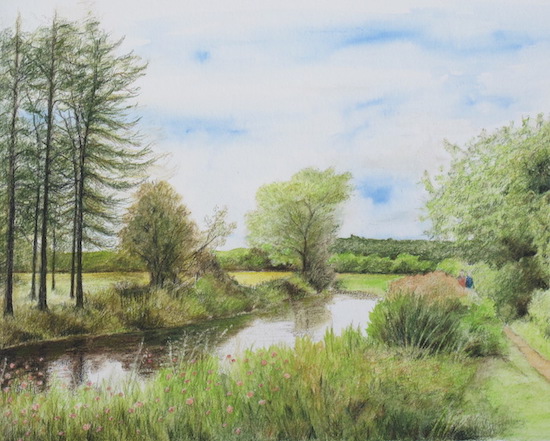- Home
- Watercolour pencils
- Watercolour brushes
Choosing Watercolour Brushes for Watercolour Pencils
Have you ever admired a watercolour pencil artwork, rich with smooth blends and bright hues, and wondered about the technique behind it?
While the pencils are important, the brush often plays a pivotal role!
Watercolour brushes are the hardworking tools that change dry pencil strokes into luminous, painterly effects. They soften edges, blend colours smoothly, and open up a range of textures you might not expect from pencils alone.
As a pet portrait and wildlife artist myself, returning to art and finding the capabilities of coloured pencils was a process of discovery.
I quickly learned that pairing the right pencils with the right brushes was fundamental to achieving the realistic, detailed results I wanted.
Understanding how different brushes work with watercolour pencil pigment can help your art progress from simple sketches to genuinely impressive pieces.
But looking at the different watercolour brushes available can feel confusing.
Sable or synthetic? Round or flat? What about waterbrushes?
Don't worry! Whether you're new to watercolour pencils or exploring them after using other mediums, this information aims to be a helpful resource.
We'll break down what you need to know, step-by-step, assisting you in choosing and using watercolour brushes to bring your pencil art to life.
Why Brushes Are Important for Watercolour Pencil Art
Watercolour pencils beautifully connect the worlds of drawing and painting. While you apply pigment with the familiar control of a pencil, it’s the brush and water that truly unlock their potential and activate the colour. Here’s why understanding brushes is very important for aspiring watercolour pencil artists:
- Blending Ability: Brushes allow you to smoothly blend colours on the paper, creating soft gradients and transitions difficult to achieve with dry pencils.
- Softening Edges: Want a softer, atmospheric appearance? Brushes can soften hard pencil lines, integrating your subject nicely with its background.
- Activating Pigment: A damp brush dissolves the pencil pigment, intensifying the colours and creating transparent washes similar to traditional watercolour.
- Creating Effects: Different brush shapes and methods allow for distinct textures – consider dappled light, soft fur, or smooth skies.
- Precision and Control: While pencils offer line control, brushes provide control over water application and pigment movement, which is helpful for detailed work.
Think of your watercolour pencil and brush working together. Learning to use them effectively is fundamental to getting the most out of this versatile medium.
Sable vs. Synthetic Brushes for Watercolour Pencils
Visit any art supplier, and you’ll encounter a primary decision: natural sable hair brushes or synthetic filament brushes? Let's look at the pros and cons specifically for use with watercolour pencils.
Natural Sable Brushes: The Premium Option
Traditional watercolourists often prefer brushes made from Kolinsky sable hair.
Pros:
- Excellent Water Holding Capacity: Sable holds a substantial amount of water and pigment, allowing for long, smooth washes.
- Superb Point and Spring: High-quality sable brushes maintain a very fine point and return well to their shape, offering great control.
Cons:
- High Cost: Genuine Kolinsky sable brushes are costly, which can be a barrier, especially for beginners or hobbyists.
- Delicate: The fine hairs can be damaged by the rubbing motion sometimes required with watercolour pencils.
- Ethical Concerns: Some artists choose to avoid animal hair products.
Synthetic Brushes: The Practical Option for Pencil Artists
Modern synthetic brushes, often made from nylon or Taklon filaments, perform very well.
Pros:
- Affordability: Synthetics cost significantly less than sable, making them accessible for all budgets.
- Durability: They hold up better to the methods often used with watercolour pencils, like lifting or moving pigment. This is helpful because activating pencil pigment requires more friction than moving wet watercolour paint.
- Good Performance: Quality synthetics offer decent water holding, good shape retention, and can maintain a fine point. They are well-suited for the blending, softening, and activating tasks required.
- Vegan-Friendly: No animal hair is used.
Cons:
- Less Water Capacity: Generally, they don't hold as much water as sable, needing more frequent dipping. For the controlled application needed with pencils, however, this can prevent accidentally overwetting your work.
- Point Longevity: Less expensive synthetics might lose their fine point faster than high-end sable with heavy use.
 See the damage to the two sables brushes on the right?
See the damage to the two sables brushes on the right?My Recommendation for Use with Watercolour Pencils
For watercolour pencils, I strongly suggest starting with good quality synthetic brushes.
Why?
The process of activating and moving pencil pigment often involves some friction on the paper surface. This can quickly damage the delicate, costly point of a natural sable brush (something I experienced with nice brushes early on!).
Synthetics are robust enough for the job, affordable enough to replace if the point wears, and offer excellent control over the amount of water applied – important for not washing out the pencil lines. Look for reputable brands known for quality synthetic filaments.
Looking at the photograph, you can see the two sable brushes on the right no longer have their original fine points – a result of using them with watercolour pencils before I switched to nylon brushes. The middle three demonstrate the sharp points these brushes should maintain. Nowadays, I typically use the synthetic brushes shown on the left for this kind of application.
Understanding Brush Shapes and Their Uses With Pencils
Beyond the material, brush shape greatly influences the marks you make.
Here are the most common shapes and how they are useful for watercolour pencil art:
Round Brushes
- Description: Pointed tip, round body. A very versatile brush.
- Uses: Good for detailed work (using the tip), filling small areas, creating varied lines (thin with the tip, broad with the side), and general blending. A few different sizes (e.g., small size 2/4, medium size 6/8) are very useful.
 Typical round brushes are highly versatile for watercolour pencil work. Notice their pointed tips for detail and the rounded body of bristles. Having a couple of different sizes, like a smaller one for fine lines and a medium one for general blending and filling, is a great starting point.
Typical round brushes are highly versatile for watercolour pencil work. Notice their pointed tips for detail and the rounded body of bristles. Having a couple of different sizes, like a smaller one for fine lines and a medium one for general blending and filling, is a great starting point.Flat Brushes
- Description: Square or rectangular, flat ferrule.
- Uses: Suited for covering larger areas quickly (washes, backgrounds), creating sharp, straight edges, and lifting colour in defined shapes. Useful for architectural elements or broad areas in nature scenes.
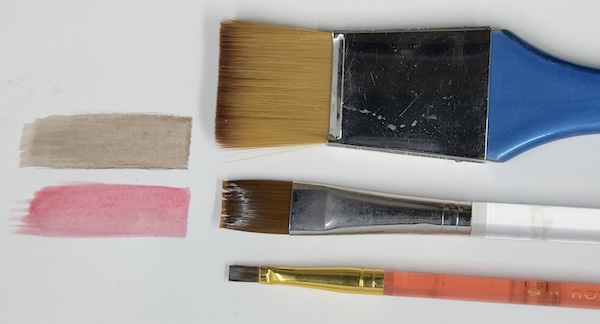 Flat brushes are ideal for creating even washes, covering larger areas, and achieving crisp, straight edges with your watercolour pencils. This selection shows different widths, from a narrow flat for smaller shapes to a wider one for backgrounds. The swatches demonstrate the smooth coverage and clean lines flat brushes can produce
Flat brushes are ideal for creating even washes, covering larger areas, and achieving crisp, straight edges with your watercolour pencils. This selection shows different widths, from a narrow flat for smaller shapes to a wider one for backgrounds. The swatches demonstrate the smooth coverage and clean lines flat brushes can produceFilbert Brushes
- Description: A filbert brush has a flat ferrule but with an oval or rounded tip, offering a versatile combination of a flat and a round brush's characteristics.
- Uses with watercolour pencils: Their shape naturally creates softer strokes and more blended edges than a standard flat brush.
- Excellent for creating organic forms like flower petals and leaves.
- Good for smoothly blending larger areas or creating softer transitions.
- Filberts can also be effective for gently dissolving and blending watercolour pencil shavings directly on paper for soft, textured effects (a technique we explore further in our How to use watercolour pencils page in the shaved Pigment Section).
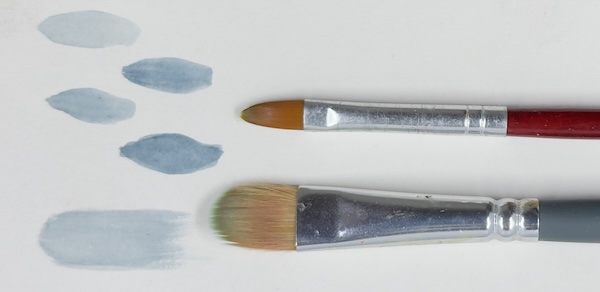 Filbert brushes, like these, show their characteristic oval tips. The sample strokes demonstrate their ability to create both broader blended areas and more shaped marks, making them ideal for organic forms
Filbert brushes, like these, show their characteristic oval tips. The sample strokes demonstrate their ability to create both broader blended areas and more shaped marks, making them ideal for organic formsLiner/Rigger Brushes
- Description: These brushes are easily recognizable by their very long, thin bristles that come to a fine point.
- Uses with watercolour pencils: Liner brushes (often called rigger brushes, historically used for painting the rigging on ships) are specifically designed for creating long, fine, continuous lines. With activated watercolour pencils, they are particularly useful for:
- Rendering delicate elements like tree branches, twigs, and grasses.
- Adding fine linear details, such as whiskers on an animal or intricate patterns
- Achieving a calligraphic, more fluid mark that differs from the line you can get with a dry pencil. While a sharp dry pencil gives precise control, a liner brush offers a flowing, painterly quality to your lines.
A Quick Tip for Best Results: To make the most of a liner brush, ensure it's well-loaded with fairly fluid activated pigment. You can do this by gently rolling the bristles in your prepared watercolour pencil wash on your palette, rather than just dabbing the very tip. This helps the long bristles hold enough colour to complete a long, unbroken stroke.
Fan Brushes
- Description: As their name suggests, these brushes have bristles that spread out in a distinct fan shape.
- Uses with watercolour pencils: While perhaps less commonly used for general application or smooth washes compared to rounds or flats, fan brushes are excellent specialist tools for creating a variety of interesting textures with your activated watercolour pencils. They are particularly useful for:
- Foliage and Grasses: By lightly dipping the tips of the fan bristles into water (or your prepared watercolour pencil wash) and then gently dabbing, flicking, or swiping over your dry pencil marks on the paper, you can create natural-looking textures for leaves on trees, clumps of grass, or even pine needles. The separated bristles help to create multiple fine marks simultaneously.
- Fur or Hair Effects: Similarly, a fan brush can be used to suggest soft fur or hair by using gentle, directional strokes.
- Other Textural Effects: Experiment with varying the pressure, the amount of water on the brush, and how much you splay the bristles to achieve different results.
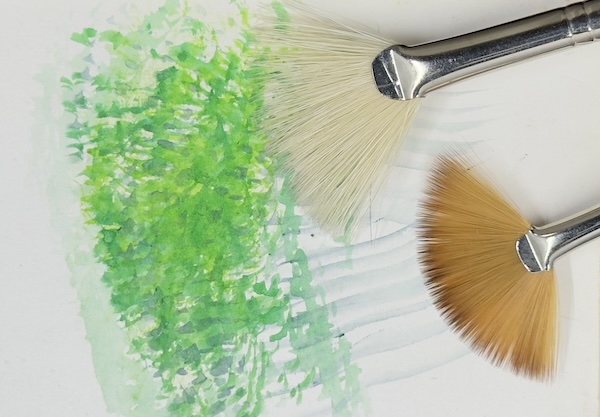 Fan brushes, with their distinctive splayed bristles, are excellent for creating natural-looking textures. As shown here with activated watercolour pencil, they can be used to build up effects like foliage, grasses, or even soft fur with light dabbing or flicking motions
Fan brushes, with their distinctive splayed bristles, are excellent for creating natural-looking textures. As shown here with activated watercolour pencil, they can be used to build up effects like foliage, grasses, or even soft fur with light dabbing or flicking motionsFinding Your Ideal Brush Fit
Choosing brushes is personal. Think about your typical subjects.
Do you prefer detailed work (rounds, liners)? Broad nature scenes (flats)? Soft florals (filberts)?
Don't hesitate to experiment. Try holding different brushes – are they comfortable? Does the brand offer good shape retention in their synthetics?
Start with a few basic rounds and perhaps a small flat, then add to your collection as you discover your preferences. Finding a brush that feels right in your hand is part of the artistic process.
The Waterbrush: Your Go-To For Portable Painting
What if you want to sketch with your watercolour pencils while you're out and about – perhaps capturing a local view, working on vacation, or simply enjoying a session in the garden – without the fuss of carrying pots of water? Then you should definitely consider the waterbrush!
A waterbrush is a wonderfully useful tool for any watercolour pencil artist.
It consists of a brush tip (which can be round, flat, or even a chisel shape) attached to a plastic barrel that you fill with water.
With a gentle squeeze of the barrel, water flows down into the bristles, allowing you to activate and blend your watercolour pencil marks wherever you are.
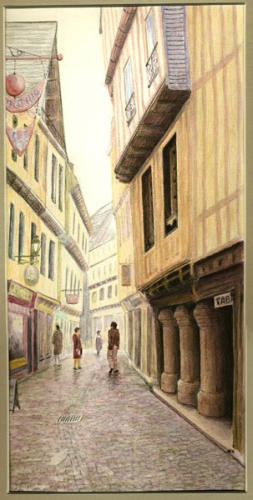 Pushing and dragging the brush enabled Peter to move pigment and create the varied tones suggesting cobblestones
Pushing and dragging the brush enabled Peter to move pigment and create the varied tones suggesting cobblestonesBenefits of using a waterbrush:
The advantages are clear, especially for sketching on the move.
- Portability: Say goodbye to separate water containers and the risk of spills! Everything you need is in one compact tool.
- Controlled Water Flow: You have direct control over how much water is released to the bristles, usually by gently squeezing the barrel.
- Convenience: They are very easy to clean – simply squeeze a little more water through the bristles and wipe them on a tissue or cloth until the water runs clear.
- Versatility: Perfect for travel sketching, en plein air (outdoor) work, urban sketching, or even for quick, mess-free practice sessions in the studio.
An example in action: I often use a waterbrush in my sketch book. In the photo below you see me testing where two watercolour pencils will blend nicely to show distant trees against the sky.
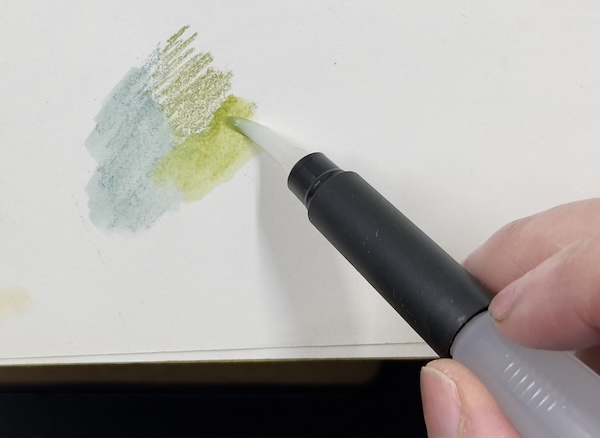 A waterbrush makes activating watercolour pencils incredibly easy, whether in the studio or on the go. Here, you can see how the water released from the brush tip is transforming the dry pencil marks into a fluid, blendable wash.
A waterbrush makes activating watercolour pencils incredibly easy, whether in the studio or on the go. Here, you can see how the water released from the brush tip is transforming the dry pencil marks into a fluid, blendable wash.Developing Your Skills Through Practice
Like any art method, skill comes with practice.
- Don't hesitate to try things out on scrap paper.
- Test different brushes, vary the water amount, see how colours blend.
- Observe how the pigment works on your paper.
This hands-on work is how you'll build confidence and find what suits your style.
Your Brushes, Your Creative Partners
As we've explored, watercolour brushes are far more than just simple tools for wetting your pencils; they are truly creative instruments that help you unlock the full, vibrant capabilities of the watercolour pencil medium.
Understanding the practical benefits of durable synthetic brushes over more delicate sables for watercolour pencil work is a key starting point. When you also get to know how different brush shapes function – from versatile rounds and broad flats to organic filberts – you truly empower yourself. These insights allow you to blend, soften, layer, and add texture to your art with much greater control and confidence.
And let's not forget the wonderfully convenient waterbrush, which opens up a world of possibilities for making colourful art achievable anywhere you go.
Choosing the right brushes for your needs and learning how they interact with your watercolour pencils is a key step in transforming your drawings into the impressive, painterly pieces you aspire to create.
Ready to improve your watercolour pencil art?
- Experiment: Take a synthetic round brush and practice activating and blending colours on scrap paper today! You can try this out with our simple pears tutorial.
- Learn More: Explore our comprehensive guide to Watercolour Pencil Techniques like layering and creating washes covering everything from layering and creating washes to more advanced creative methods.
- Get Inspired: Sign up for our occassional newsletter for more tips, tutorials, and insights.
Your progress with watercolour pencils begins with picking up the brush. Happy painting!
Improve Your Pencil Art: Get Free Tips & Techniques
Sign up for our newsletter – just occasional emails packed with practical advice and inspiration for pencil artists like yourself
